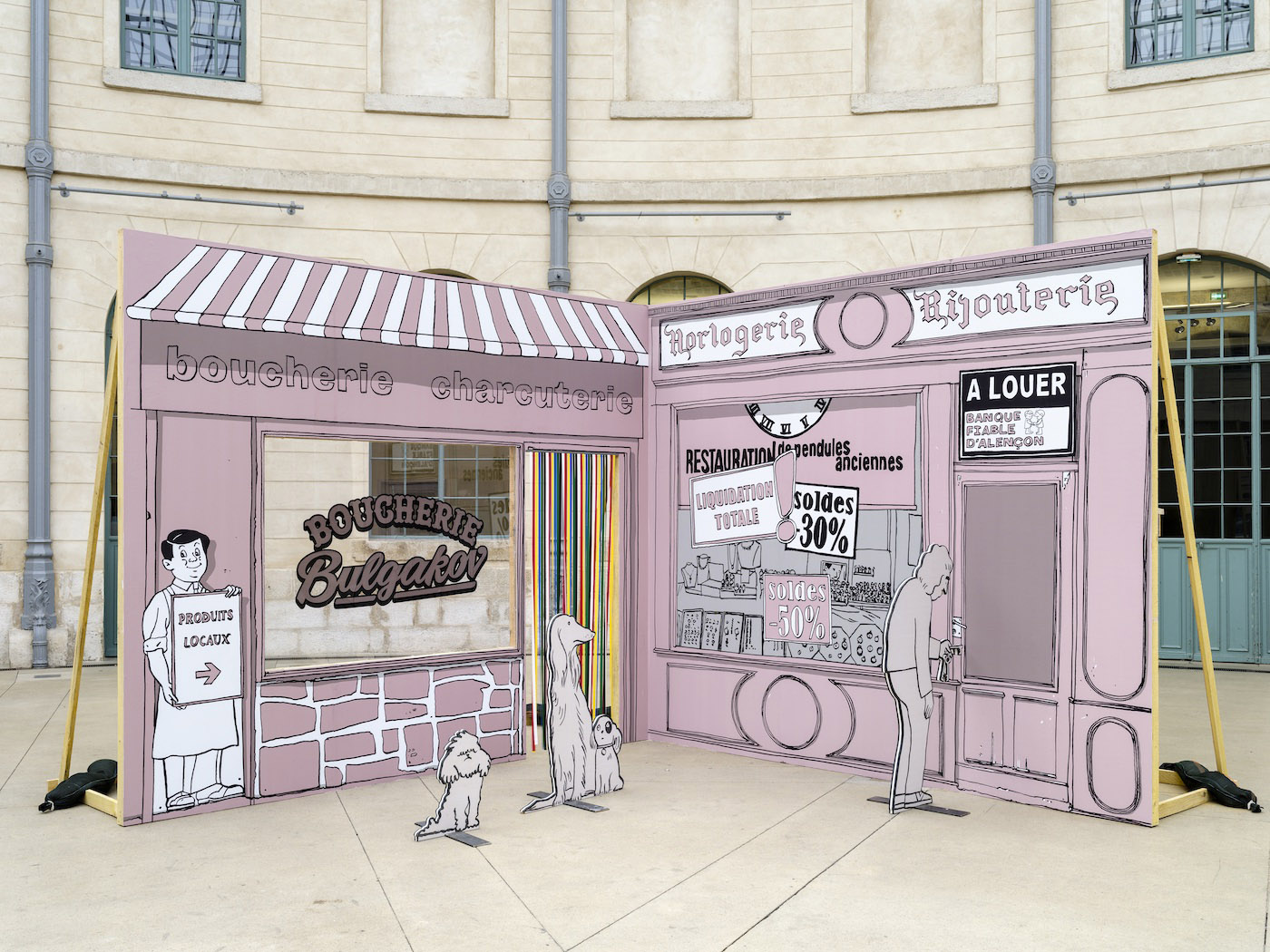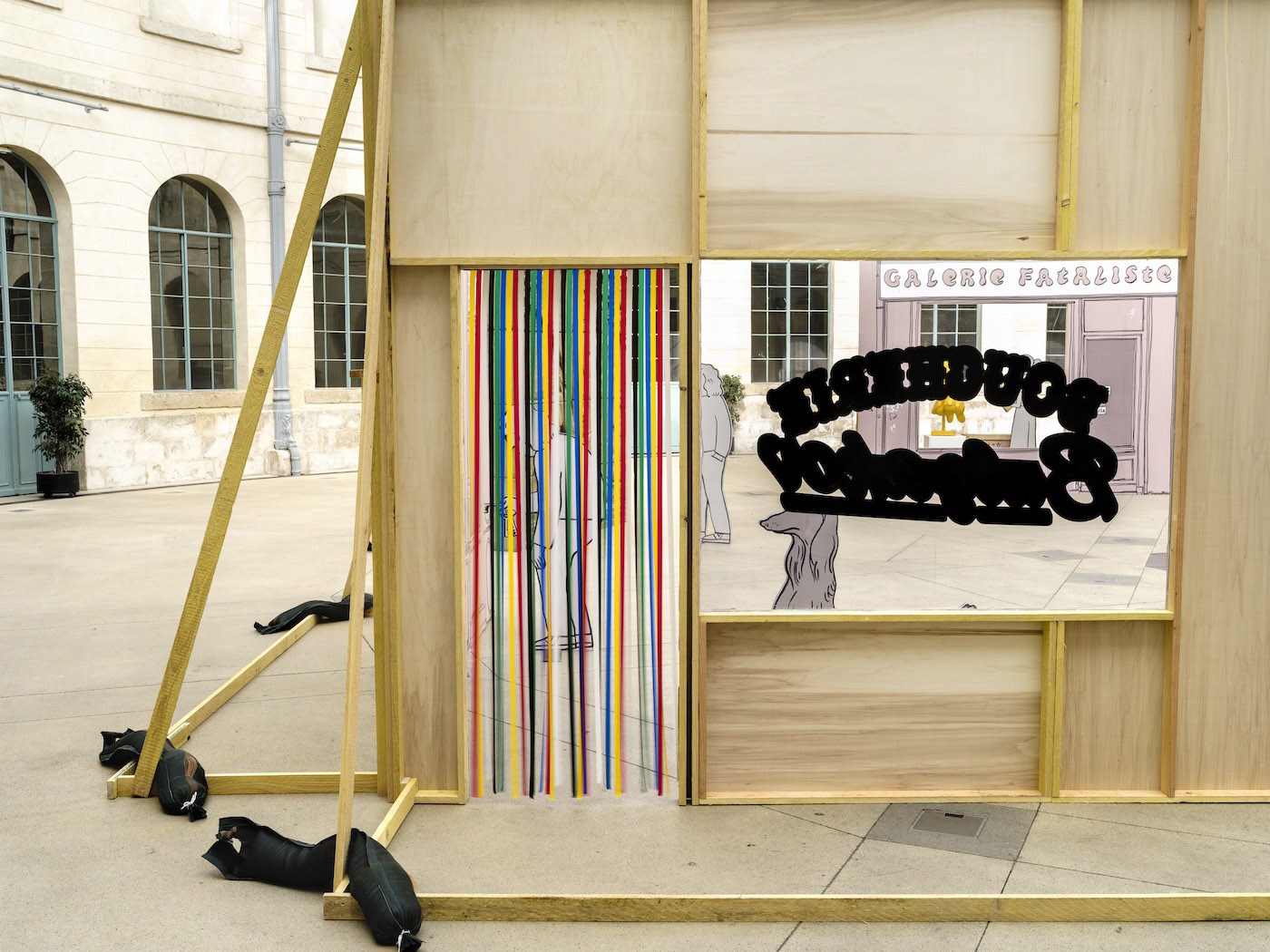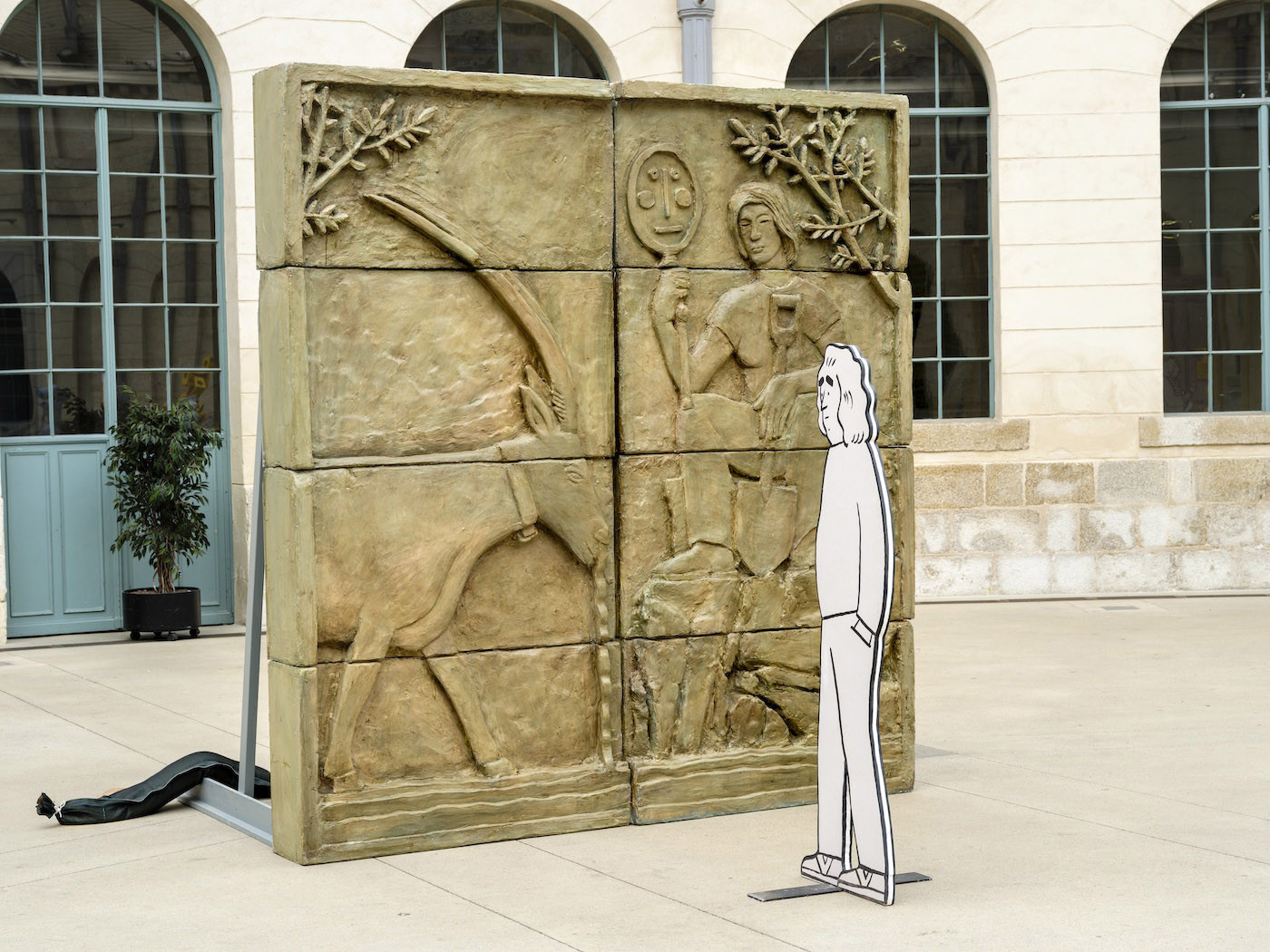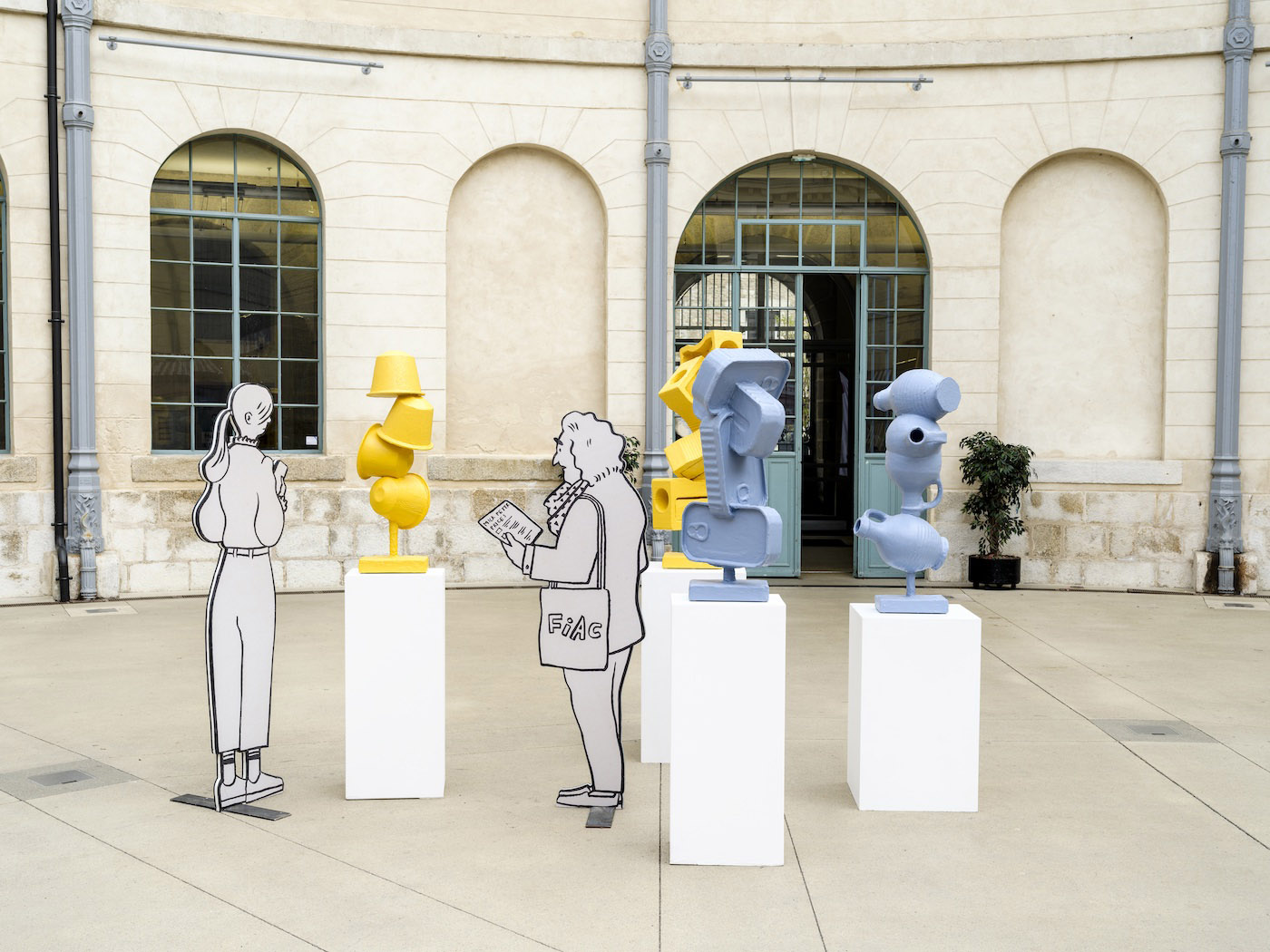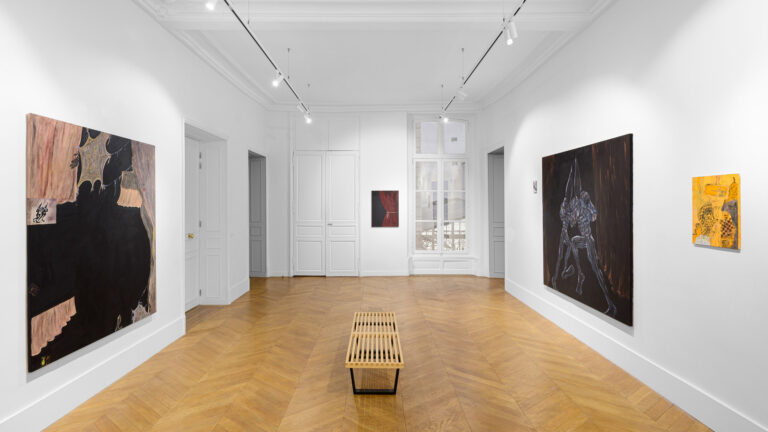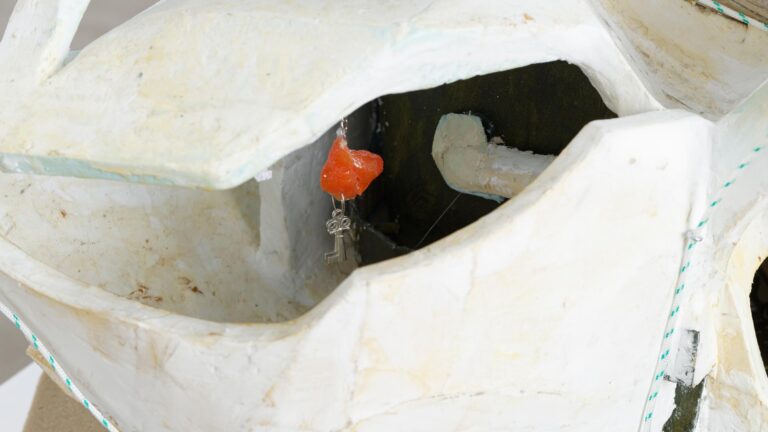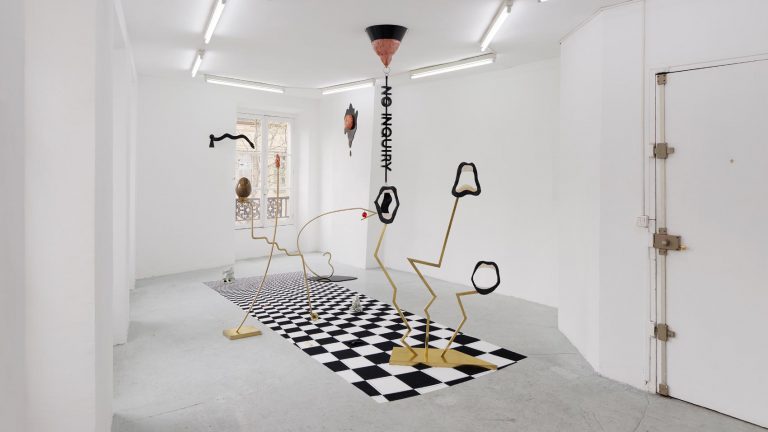Artist: Mick Peter
Exhibition title: Six Scenes
In collaboration with: Les Bains-Douches
Venue: La Halle au Blé, Alençon, France
Date: October 6 – 22, 2023
Photography: Michaël Quemener / all images copyright and courtesy of the artist and Les Bains-Douches
I used to work as an editor for an art magazine. My job involved a great deal of travel. Much of my time on the road was spent following the international circus of art fairs and biennial exhibitions. These big shows were good places for people watching. They were magnets for every kind of art world stereotype; a parade of professionals in uniform, each outfit subtly—and not so subtly—signalling their wearer’s position in the art industry. My colleagues and I had a checklist of types. Successful artists in discreetly expensive t-shirts and designer trainers, for example. Exhausted critics laden with grubby cotton museum tote bags. Young art dealers trying to split the difference between dressing their age and dressing like their older rich clients. Art handlers wearing heavy toolbelts, swaggering like gunslingers in a Western.
One category we named Rich Guy Blue. It was shorthand for a certain type of wealthy, middle-aged collector, always in suede loafers and a royal blue coloured shirt, a shade designed to perfectly complement skin tanned to the colour of expensive leather. Wherever I travelled—Basel, New York, Paris, São Paolo—there was Rich Guy Blue, a cartoon come to life. Rich Guy Blue had an eccentric cousin. Same shirt, same expensive tailoring, but with frayed collars and cuffs, a detail distinguishing old money from new. To these basics he would add a patterned silk scarf and swap the loafers out for monogrammed slippers. His long, steel-grey hair would be worn in a dated pageboy-style cut, and instead of a tan, his complexion would be the colour of claret. I often sensed that this was a person who privately felt out of his depth around contemporary art. A man more comfortable with antiquarian books and early moderns, but, out of duty to his younger self—perhaps also to a younger partner— obliged to stay curious about the zeitgeist, about the artists and writers everyone was talking about.
This man drifts through Mick Peter’s Six Scenes at the Halle au Blé in Alençon. Peter captures him at the Foire Internationale d’Art Contemporain (FIAC), price list in his hand, looking at a group of bright blue and yellow sculptures representing oversized sardine tins, pretzels, Nespresso pods, and pencil sharpeners, fused together and kebabed into little monochrome towers. He’s being watched by a bored young art dealer, one eye on him, the other on her phone. The dealer’s hair is scraped into a ponytail, she wears a blouse with little puff sleeves, cropped trousers, plain but chic shoes, the sort you might have once worn to school, hated, and now feel nostalgic about.
There he is again, this time at home. It’s an elegant, wood-panelled apartment with tall ceilings, big windows, and mid-century modern furniture. (Original pieces, tatty and patinaed.) A Michel Houllebecq novel rests on an antique side table. A pair of the yellow tower sculptures, from the same series as the ones at the art fair, stand sentry at opposite corners of the room. Hanging on the walls are banana-yellow drawings reminiscent of Saul Steinberg illustrations—comic, self-aware, urbane —and images that might be European takes on Pop art of the 1960s, Pop with a heightened Surrealist accent. The collector enjoys a glass of wine. You might say he looks content in his bubble of taste. Or you might think he looks anxious about what, if anything, the art and the literature he owns has to say about the town outside his apartment. Perhaps he is uneasy because the view from his apartment, located inside the Halle au Blé, looks across the street onto the Halle au Blé. His home, it seems, is a mise-en-abyme, a place from which he cannot avoid watching himself watch himself. He is trapped in a kind of self-surveillance of consumer choices, of behaviours, of which shade of Rich Guy Blue shirt and scarf to wear, which Houllebecq novel to be seen to read. A prison of taste.
Somewhere along the street from his apartment is the gallery from which he bought his art works. The owner of Galerie Fataliste—the young woman with the ponytail—can be seen through the window of her gallery. She holds in her hands one of the banana-yellow drawings that hang in the collector’s apartment. It depicts a caricature 20th-century modern artist with a beret, pipe, long beard, probably stinking of wine. He’s carrying a painting of a reclining nude under his arm. The gallerist stares hard at the image. Perhaps she is trying to internalize its meaning so she might do a better job of selling it. Peter doesn’t tell us whether this scene is set before or after the collector came by to spend his money: the scene in his apartment may simply be the dealer’s dream of a good sale.
Judging by the gallery facade, this is a small business on a rundown street. The paintwork looks chipped. The door has warped a little in its frame. Spindly graffiti tags edge the windows like little clusters of curious insects. It looks like kind of shopfront that was once, say, a grocery or a bookshop, a small business that could no longer afford the rent in a town now friendlier to luxury cosmetic stores and upscale farm-to-table restaurants.
Around the corner from the gallery is a watch repair shop. It has seen better days. The owner, dressed in a plain sweater and sneakers, is locking up for the day. He looks strikingly similar to the collector. They could be brothers whose lives were long ago split by money. Or they might be the same man, one flesh-and-blood, the other a fantasy of the life he’d like to lead, although it is impossible to tell which one is real and which one lives in the imagination. In the window of the watch store are signs advertising a liquidation sale, offering thirty, fifty percent off. A ‘for rent’ sign is fixed above the door. To the right of the entrance, the shopfront panelling looks like a giant exclamation mark, the punctuation to a sad joke. Next door is Boucherie Bulgakov. This business, at least, seems to be surviving. Outside are three dogs gazing in the window, hoping that the butcher might throw them a few cuts of meat. (They need to be careful. In his satirical novel The Heart of a Dog, another Bulgakov—Mikhail, the Russian author—tells the story of a stray, lured by offers of sausage from an unscrupulous surgeon, then implanted with the pituitary glands of a human, causing a painful transformation into a man.)
Peter takes the watch shop owner over to the local museum. There he can be seen admiring a large wall relief depicting a rural scene. Under the boughs of trees, an antelope approaches a young woman who is sat on a small pile of rocks. She wears boots and wide-leg work trousers. In one hand the woman holds a spade, in the other, a staff capped with a crudely designed image of a face. What the antelope and the woman represent is unclear; a rural custom, an annual event in the agricultural calendar, something once legible to anyone but now lost to progress. For many museum visitors it is simply a relic of how life once was—just like a corn exchange or a watch shop. As with all the scenes Peter shows, we don’t know when this museum visit happened: it could be in the past, during happier days for the watch shop proprietor’s business, or it could be the first day after it closed down, when anything featuring obsolete symbolism begins to holds a new significance for him.
A sense of time slipping away, of inexorable obsolescence, haunts all six scenes that Peter has built for the Halle au Blé. The character of town streets alter according to movements of people and commerce. Everyday customs turn alien; the kind of routine sights that, say, one’s grandparents would have taken for granted, now reduced to frozen museum dioramas. Desirability, relevance, expertise, fashionability; these, Peter seems to say, are just brief flowerings.
Brevity is built into the form of these works. They are built like theatre flats. Sheets of board held upright with props, made to deceive the eye from one angle only. These shops and characters look as if they have been pulled from a stage or a movie studio, designed to be constructed fast or packed down at a moment’s notice. His people—the dogs too—are rendered with the deft, economical line of the caricaturist or book illustrator. Just a few strokes of a pen is all it takes for Peter to tell his audience what we’re looking at. The style feels fast and direct, and suggests an accessible kind of image we can all recognize. Each scene looks as if it could be enlarged from a book for children describing how a town works or the types of jobs that grown-ups do. Or these might be satirical sketches in a newspaper—cartoons waiting for a caption—lampooning the follies of politics or contemporary art. Just like scenography, a cartoon is something made fast and used quickly. It is made to communicate meaning efficiently. The kind of image that might make you laugh over your morning coffee, then forget about moments later, as the day’s demands start to press down.
Peter’s graphic style belongs to a certain class of functional image; not to the gallery but to the shop sign, the kid’s book, the local tourist board website. These scenes are also containers for other works. They’re pictures holding pictures, a two-and-a-half-dimensional representation of the world. The shopkeeper is a flat cut-out, but the wall relief in the museum is three-dimensional, possessing volume and weight. The sculptures in the art fair scene are real— they’re from Peter’s 2021 series ‘Tasteful Sculptures for a Business Leader’—yet in the collector’s apartment they shrink to two-dimensions. The drawings on the walls of his home are Peter originals, from the series ‘Banana Drawings,’ but the apartment is simply cut-out sheets of wood. Taken together, these different orders of image and object —the two- and three-dimensional; original and reproduction; cartoon and cut-out—describe aspects of the psychological relationship we have to the visual world. It’s a perceptual spectrum that runs from real things to a stylized idea of them. Peter describes a tension between what a picture or an object is and what we label it as, how we remember it, code it. Here is a thing, now file under: “shop,” “art,” “dog,” “Rich Guy Blue.”
Perception is a question of convenience and efficiency. It’s a system that must work fast, so as to allow us to move freely through the world without getting too confused about categories of people and things every time we step out of the house. We hold in our heads an idea of the world that is partly complex, subtle, and made up of infinite shades of grey; the people we care about, say, or our areas of professional expertise. But the aspects of life we don’t need to pay attention to are like a cartoon, a couple of marks on a blank sheet of paper, just the basics, enough to give us a rough idea. Sooner or later—as we age, as the world turns—our personal perceptual system begins to crack and peel. We find that graffiti tags appear along its edges. It acquires a dated pageboy haircut and monogrammed slippers. It will reference books that everyone else stopped talking about years ago. Its collars and cuffs will fray. Eventually, it may need to be packed down, like a film set at the end of a shoot, or it will find new uses, like an old corn exchange in a small city.
-Dan Fox








